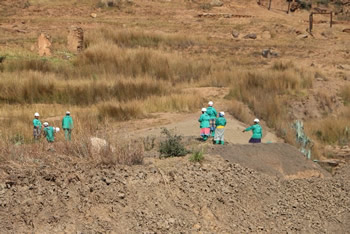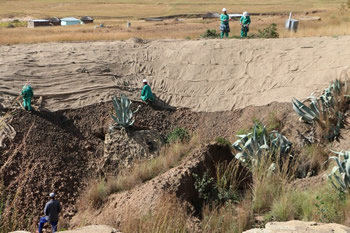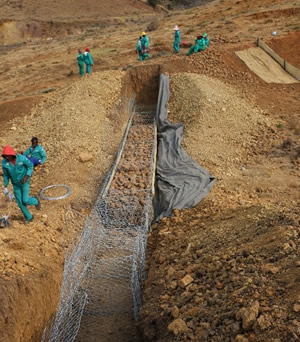Working for Ecosystems
Introduction and background
It is estimated that nearly 5.7 million hectares of untransformed land in South Africa has been degraded. To optimise the benefits from this land there is an urgent need for a country-wide land restoration programme to address this challenge. The need for such a programme are emphasised by the fact that by far the largest component of degraded land are situated in the former homelands where dependence on natural resources, high population densities and unplanned extraction and management of natural resources (especially wood and unsustainable grazing and fire regimes) reduced livelihood options. These poor, and energy and food insecure communities have relied heavily on biomass for survival over many decades. This led to rural communities being caught up in a seemingly ever-worsening poverty-degradation spiral. This spiral has to be broken if South Africa’s marginalised rural poor who operates within the 2nd economy of the country are to enter the 1st economy. The restoration of degraded land might be such a strategy. Overstocking and unsustainable grazing and fire regimes in free-hold title areas of commercial agriculture, and a lack of capacity to administer the Conservation of Agricultural Resources Act (CARA) has also lead to vast areas being severely degraded (Lloyd et al 2002) due to the
Land restoration is aimed not only at restoring the natural resources/capital but, given rural communities’ affection and attachment to their land, restoration has huge potential to also restore both social and financial capital of the rural communities. Restoration could therefore contribute greatly towards addressing one of government’s big challenges – namely to address rural poverty. If nothing drastic and active is done, rural people who 3 have been poor and who are poor, will remain poor because they have no product to sell and they have no (or extremely limited) access to markets. Working for Ecosystems is a vehicle that offers a unique opportunity in that it will provide rural commodities essential for urban (and international) economies in the form of environmental goods and services.
The programme also aims to provide access to markets for rural people in that the regenerated ecological services provide products wanted by metropolitan. Rural people can supply these services and so improve their livelihoods. The market comes to them! The activity is local, while the benefits and services are both local and global. The added benefit is that not only is this initiative not based on aid, hand-outs and a perpetuation of rural-dependency, but people are being drawn into the formal (1st) economy by providing a product. It is trade – not aid! By being financially compensated, those who were formerly outside the financial sector and who never had a cash income do have the opportunity now to enter the formal financial sector. With initiatives like Working for Water, Working for the Coast, Working on Fire, Working for Wetlands and now also Working for Ecosystems the formerly marginalised are able to enter the 1st economy!
Unlike many other rural development programmes, the market for woodland restoration is not confined to government-funded programmes. Land restoration has the ability to be funded through private funding in the form of carbon sequestration (for both a local and global audience), the provision of water regulation and purification services (for the local market), and the development of tourism opportunities. The programme needs to be kick started though through government interventions. Once the market has been established it has the potential to reach a critical financial mass and broad-based support that could be turned into a sustainable and viable economic sector. This, however, is a long-term vision starting with restoration.
Unlike many other rural development programmes, the market for woodland restoration is not confined to government-funded programmes. Land restoration has the ability to be funded through private funding in the form of carbon sequestration (for both a local and global audience), the provision of water regulation and purification services (for the local market), and the development of tourism opportunities. The programme needs to be kick started though through government interventions. Once the market has been established it has the potential to reach a critical financial mass and broad-based support that could be turned into a sustainable and viable economic sector. This, however, is a long-term vision starting with restoration.
Aims and objectives
Working for Ecosystems aims to reverse environmental degradation through ecological restoration and maintenance programmes. It aims to regain natural habitat composition, structure and function and thereby enhance ecosystem services, such as: carbon sequestration, water regulation and purification, reducing the risk of natural disasters by improving landscape/catchment stability and resilience. This will improve livelihoods security and productive potential of land, improve natural species diversity, and promote the development of a market for ecosystem services and pro-poor economic development and empowerment in rural areas.
Here we follow the definition developed by the Society for Ecological Restoration and consider ecological restoration as the process of assisting the recovery of an ecosystem that has been degraded, damaged, or destroyed (SER 2002).
The Working for Ecosystems programme aims to:
- Improve watershed services through the restoration of watersheds (mountain catchment) services, riparian zones and wetlands in collaboration with Working for Wetlands, Working for Water and Working on Fire.
- Contribute to climate mitigation through the sequestration of carbon in the form of re-vegetating denuded landscapes.
- Contribute to adapting to the impacts of climate change and improving livelihood security by reducing the risk of natural disasters through the restoration of degraded habitats.
- Unlock investments and operational resources for the improvement of the quantity and quality of ecosystem services as referred to in 1 – 3 above.
- Promote pro-poor economic development in rural areas through 1 – 4 above.
Key Focus Areas
1. Promotion of the restoration and maintenance of watersheds in the process ensure the following services:
a. Improve Flows
i. Decrease Flood/high flows
- Improve water yield at time of Low Flows;
- Improve yield from existing and new water infrastructure, and
- Improve the Ecological Reserve, through the restoration and improvement of land management practices and the control of invasive alien plants.
b. Minimize Sediments
- Decrease siltation of dams and other infrastructure through restoration, improvement of land management practices and the control of invasive alien plants.
c. Achieve Optimal Water quality
- Improve water quality to limit purification costs;
- Reduce spread and cover of waterweeds, and
- In order to decrease health risks where water is extracted directly from rivers, improve water quality, through restoration, improvement of land management practices and the control of invasive alien plants.
Hypothesis and Rationale
Hypothesis
It is possible to address South Africa’s rural unemployment, poverty, and environmental degradation simultaneously and sustainably through a programme that integrates the restoration of natural capital, the development of markets for ecosystem goods and services, and economic development over a period of time.
Rationale
To address the hypothesis the country need to integrate economic and ecological thinking into a strategy to restore natural and social capital. Poverty, unemployment, and environmental degradation are signs of the failure of both government policy and commitments and markets to evolve naturally. The socio economic challenge is to integrate the 2nd and 1st economies in rural areas where unemployment is rife.
Government is committed to address the (widening) economic divide between the 1st and 2nd economies and such a woodland restoration programme offers and ideal opportunity to do just that.
With regards to natural resource degradation, South Africa is signatory to various international conventions, but the three major ones are the UN’s climate change convention, the convention to combat desertification and to conserve biodiversity. A restoration programme will assist government, and DEA specifically, to adhere to all three these conventions in one programme. Furthermore through its acts, DEA is obliged to promote and regulate:
- Conserving other environmental services such as water quantity and quality,
- Fighting poverty through the creation of employment opportunities, and
- To promoting tourism.
A restoration programme will assist DEA to fulfil its mandate. The Department’s Environmental Potential Atlas, and abundant evidence from other sources, indicates that these objectives are not being achieved. The Working for Ecosystems programme (WfE) is an initiative that is responding to the abovementioned challenges through restoring secured natural capital and thereby providing a flow of ecosystem goods and services and enhance the well being of people. Through the restoration current and future natural resource needs for society can be secured.
The DEA business plan (Faranani) for 2005/06 clearly states the department’s intention to restore natural resources through its Expanded Public Works Programme (EPWP) referring specifically to land, wetlands, and riparian areas. Working for Ecosystems will contribute to the DEA goal of Promoting Conservation and Development of Natural Resources and contributes to the strategic objective of Protection of Sensitive Environmental Areas. The programme therefore clearly fits in the key performance area of Conservation of Landscapes and Coastal Areas. In the DEA business plan focus area, the Specific Key Performance Indicators are: “(1) Hectares of land regenerating towards the restored state and 2) kilometres of rivers and lakes cleaned and restored.”
Over and above the DEA rationale for land restoration, the programme will contribute to the implementation of the Department of Agriculture Forestry and Fisheries Woodland Strategy. The strategy makes specific reference to the restoration of land. It states that the department will “Promote research on best methods for land resource rehabilitation (soil, flora, fauna etc.)” and “Support/facilitate development and implementation of rehabilitation and maintenance plans (e.g. Working for Wetlands, Working for Ecosystems, LandCare, Desert Margins Programme etc.). Furthermore the National Forestry Programme, among others, include:
- Community Forest Management (Land, Small Indigenous Forests and Woodlots)
- Management of Ecological Services (Climate Change, Soil & Water Conservation) and
- Forest Protected Area System Planning (Integrated Conservation Planning and Forestry Biodiversity Hotspots)
Under Community Forest (Land) Management, reference is being made to: "The introduction of incentives for sustainable woodland management. This could be implemented in a number of ways of which one is “Promotion of rehabilitation Forestry”. Section 17 of the National Forest Act, 1998, gives the Minister of Water Affairs and Forestry powers to intervene to prevent deforestation and to rehabilitate deforested areas. It states that a national programme of forest rehabilitation, linked to the LandCare programme, Working for Ecosystems and the Expanded Public Works Programme, could have the triple benefit of combating degradation, providing fuel wood sources and carbon sinks, and environmental benefits through supply of ecosystem goods and services, such as water regulation and purification. It further states that: "There is a concern that land across a range of landscapes and tenure systems are not sustainably managed, and that the concept of sustainability itself is poorly understood. Root causes and barriers to sustainable woodland management is a lack of understanding of the system. Differences in seed dispersal, seedbed conditions, herbivory, soil moisture, shading, and fire frequency influence seedling establishment and over-utilisation. One or more of these factors may critically constrain natural regeneration at a restoration site.”
Restoration strategies and propagation
Restoration Approaches
Visibly Degraded Areas
The approaches to restoration will differ depending on the levels of degradation, and is very context specific. Visibly degraded landscapes might well be able to recover without active restoration, if human disturbances are either removed or minimised. This might mean that the utilisation patterns of local communities need to change. Two typical examples are the following:
- When a forest or woodland has been degraded as a result of unsustainable harvesting of building material and fuel wood from the area, alternative sources of these materials can be created through artificially established woodlots. The community can then benefit, not only from the establishment and sustainable harvesting of such a woodlot but also from the protection of the natural woodland in order for it to recover. Ultimately the net carbon in such an area will increase and the community could benefit further by accessing the carbon market.
- When land has been degraded as a result overgrazing but still has some productive potential, again, the utilisation can be withdrawn, and alternative sources be established to allow the woodland to recover before utilisation at a sustainable level is being reintroduced.
Heavily Degraded Area
In the case of heavily degraded areas where the woodland has lost the ability to recover on its own active restoration of the resource and processes is needed. In this case the woodland will already be so degraded that the community have hardly any benefit from it. There will therefore be a minimal short-term demand for the use of the land until such time as it has recovered to the extent where it can produce utilisable products. The community therefore will benefit by “selling their labour” to the restoration project. During this phase alternative land/resource uses should be established in order to ensure the long-term survival of the woodland. In order to implement a successful restoration project of this nature the supply of restoration material becomes important. This in itself will create opportunities to propagate restoration material in a substantial number of SMME/community nurseries. These nurseries in turn will be given an opportunity to establish themselves by supplying the project but should be supported to access the wider market for greening material for local authorities, commercial companies and other government agencies. One of the ultimate objectives of the Working for Ecosystems programme is to improve the scenic value of the landscape for nature-based tourism. This in itself will develop a market for material from the community nurseries. The initial restoration project will however act as catalyst to establish these nurseries.
Monitoring and evaluation
The monitoring and evaluation programme for Working for Ecosystems and will be developed in such a way that it can act as a capacity building programme for natural resource management graduates as well. The M&E programme will be made up of three components and variables:
- Monthly M&E Reporting Framework
- Areas treated
- Employment
- Training
2. Periodic M&E Surveys
- Hectare regenerating
- Habitat recovery
- Carbon sequestration
- Improved biodiversity
- Compositional and structural regeneration, recovery and ecosystem functionality
- Water retention and landscape stability (erosion, combating desertification)
Extent of measurable economic empowerment, which is the sum total of opportunities to access markets, access to capital and capital equipment, access to functional and management training, access to product and service development, and access to mentoring/advisory services. (To what extent did beneficiaries bridge the economic divide between the 1st and 2nd economies)
Data collection and collation will be done by interns and graduate students while the analysis will be done in the form of a post graduate programme in collaboration with local universities. There is also potential to train up a group of people in data collection techniques – these individuals could be fast tracked to find employment in SANParks, Water User Associations and other Conservation Agencies etc...
3. M&E Feedback Loop
Analysed data will be presented to a management review group who in turn will feed the information and recommendations back to the relevant management agencies (implementers/implementing agencies).
Periodic M&E reports will be technical summaries of operational, social and ecological progress and achievements, written for the management review group who are experts in their respective fields. Management will have to take into account that the reviewers, among other things, will be asked to comment on the management/implementation philosophy and methods adopted, the quality of the restoration, the results and outputs of the project, and whether or not Working for Ecosystems is receiving 'value for money".






